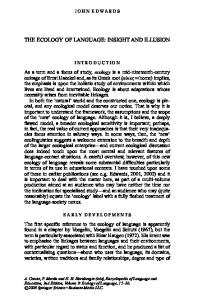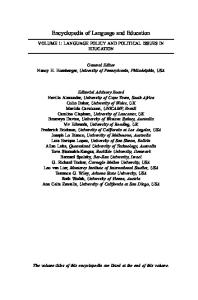The Language Ecology of Singapore
- PDF / 114,645 Bytes
- 13 Pages / 439.37 x 663.307 pts Page_size
- 63 Downloads / 337 Views
THE LANGUAGE ECOLOGY OF SINGAPORE
INTRODUCTION
The language ecology of Singapore has been shaped by educational policy, which in turn has been a response to a particularly complex language ecology. Concepts of indigeneity are meaningless in this city state, which has been a multicultural trading port since at least the fourteenth century (Gupta, 1994; Miksic, 2004), and whose present language make-up is the result of British colonialism and associated immigration in the nineteenth century (Gupta, 1994; Platt and Weber, 1980). The colonial government manipulated the delivery of education as a tool of ethnic management and social engineering, and this policy has been continued by the government of independent Singapore (Benjamin, 1976; Bloom, 1986; Chua, 1995; Gopinathan, Pakir, Ho and Saravanan (eds), 1998; Gupta, 1994; Murray, 1971; Pennycook, 1994; PuruShotam, 1998; Tan, Gopinathan and Ho (eds), 1997; Tremewan, 1994). The extreme societal and individual multilingualism of the early twentieth century (Kuo, 1976; Murray, 1971; Platt and Weber, 1980) has given way to a linguistically more homogeneous society, in which the norm is for everyone to be able to use English and the official language associated with their officially defined race (either Malay, Mandarin Chinese or Tamil). Considerable language shift to English and Mandarin, mostly from non-official languages, has taken place. The entire population is now much more linguistically united than it was, through English, and the Chinese population is also more united than in the past, through English and Mandarin. Those born after independence are likely to know fewer languages, and are less likely to have some knowledge of a language associated with another ethnic group than are those born in the 50 years before independence. Some aspects of the linguistic ecology of Singapore are shared with the whole Malay world (potentially extending as far as modern Thailand and modern Australia), and even more is shared with (modern) Malaysia and Brunei Darussalam, to which Singapore has close historical and geographical links. But Singapore has always been, to varying degrees, politically distinct from the wider region, and in this paper I will link it to the wider region only when that is unavoidable. A. Creese, P. Martin and N. H. Hornberger (eds), Encyclopedia of Language and Education, 2nd Edition, Volume 9: Ecology of Language, 99–111. #2008 Springer Science+Business Media LLC.
100
A N T H E A F R A S E R G U P TA DEVELOPMENTS
Modern Singapore is a city state, about 640 sq km in area, built across over 30 islands, many of them very small. It is located in calm waters at the southern tip of mainland Asia, where the monsoons of the South China Sea and the Indian Ocean meet, at a crucial point on the trade routes that link China, India, and Arabia. In this small corner of the Malay region, there are cities and the ruins of cities that are or were international trading posts, such as Sri Vijaya, Malacca, Banten, Banda Aceh, and Singapore (the classic history is Wheatley,
Data Loading...











